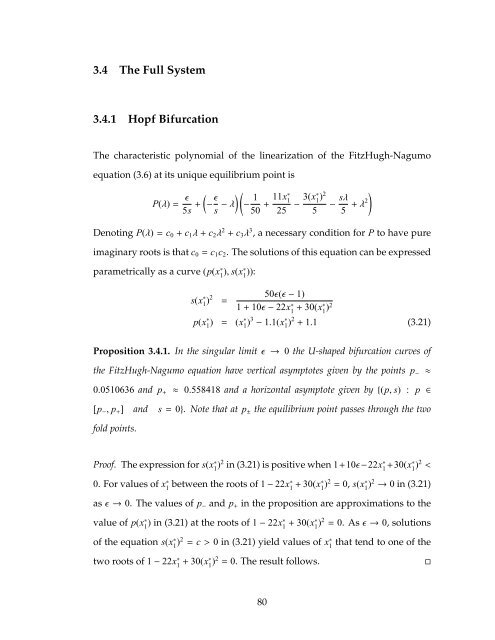multiple time scale dynamics with two fast variables and one slow ...
multiple time scale dynamics with two fast variables and one slow ...
multiple time scale dynamics with two fast variables and one slow ...
Create successful ePaper yourself
Turn your PDF publications into a flip-book with our unique Google optimized e-Paper software.
3.4 The Full System<br />
3.4.1 Hopf Bifurcation<br />
The characteristic polynomial of the linearization of the FitzHugh-Nagumo<br />
equation (3.6) at its unique equilibrium point is<br />
P(λ)= ǫ<br />
5s +<br />
<br />
− ǫ<br />
s −λ<br />
<br />
− 1<br />
50<br />
+ 11x∗<br />
1<br />
25<br />
3(x∗ 1<br />
− )2<br />
−<br />
5<br />
sλ<br />
5 +λ2<br />
<br />
Denoting P(λ)=c0+ c1λ+c2λ 2 + c3λ 3 , a necessary condition for P to have pure<br />
imaginary roots is that c0= c1c2. The solutions of this equation can be expressed<br />
parametrically as a curve (p(x∗ 1 ), s(x∗ 1 )):<br />
s(x ∗<br />
1 )2 =<br />
50ǫ(ǫ− 1)<br />
1+10ǫ− 22x ∗<br />
1<br />
+ 30(x∗<br />
1 )2<br />
p(x ∗<br />
1 ) = (x∗ 1 )3− 1.1(x ∗<br />
1 )2 + 1.1 (3.21)<br />
Proposition 3.4.1. In the singular limitǫ → 0 the U-shaped bifurcation curves of<br />
the FitzHugh-Nagumo equation have vertical asymptotes given by the points p− ≈<br />
0.0510636 <strong>and</strong> p+ ≈ 0.558418 <strong>and</strong> a horizontal asymptote given by{(p, s) : p ∈<br />
[p−, p+] <strong>and</strong> s=0}. Note that at p± the equilibrium point passes through the <strong>two</strong><br />
fold points.<br />
Proof. The expression for s(x ∗<br />
1 )2 in (3.21) is positive when 1+10ǫ−22x ∗<br />
1 +30(x∗<br />
1 )2 <<br />
0. For values of x∗ 1 between the roots of 1−22x∗ 1 + 30(x∗ 1 )2 = 0, s(x∗ 1 )2→ 0 in (3.21)<br />
asǫ→ 0. The values of p− <strong>and</strong> p+ in the proposition are approximations to the<br />
value of p(x∗ 1 ) in (3.21) at the roots of 1−22x∗ 1 + 30(x∗ 1 )2 = 0. Asǫ→ 0, solutions<br />
of the equation s(x∗ 1 )2 = c>0 in (3.21) yield values of x∗ 1 that tend to <strong>one</strong> of the<br />
<strong>two</strong> roots of 1−22x∗ 1 + 30(x∗ 1 )2 = 0. The result follows. <br />
80
















